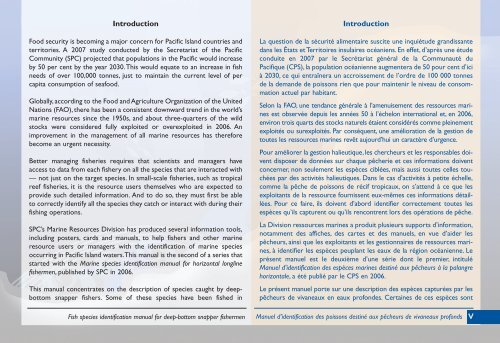Fish species identification manual for deep-bottom snapper ...
Fish species identification manual for deep-bottom snapper ...
Fish species identification manual for deep-bottom snapper ...
You also want an ePaper? Increase the reach of your titles
YUMPU automatically turns print PDFs into web optimized ePapers that Google loves.
Introduction<br />
Food security is becoming a major concern <strong>for</strong> Pacific Island countries and<br />
territories. A 2007 study conducted by the Secretariat of the Pacific<br />
Community (SPC) projected that populations in the Pacific would increase<br />
by 50 per cent by the year 2030.This would equate to an increase in fish<br />
needs of over 100,000 tonnes, just to maintain the current level of per<br />
capita consumption of seafood.<br />
Globally, according to the Food and Agriculture Organization of the United<br />
Nations (FAO), there has been a consistent downward trend in the world’s<br />
marine resources since the 1950s, and about three-quarters of the wild<br />
stocks were considered fully exploited or overexploited in 2006. An<br />
improvement in the management of all marine resources has there<strong>for</strong>e<br />
become an urgent necessity.<br />
Better managing fisheries requires that scientists and managers have<br />
access to data from each fishery on all the <strong>species</strong> that are interacted with<br />
— not just on the target <strong>species</strong>. In small-scale fisheries, such as tropical<br />
reef fisheries, it is the resource users themselves who are expected to<br />
provide such detailed in<strong>for</strong>mation. And to do so, they must first be able<br />
to correctly identify all the <strong>species</strong> they catch or interact with during their<br />
fishing operations.<br />
SPC’s Marine Resources Division has produced several in<strong>for</strong>mation tools,<br />
including posters, cards and <strong>manual</strong>s, to help fishers and other marine<br />
resource users or managers with the <strong>identification</strong> of marine <strong>species</strong><br />
occurring in Pacific Island waters.This <strong>manual</strong> is the second of a series that<br />
started with the Marine <strong>species</strong> <strong>identification</strong> <strong>manual</strong> <strong>for</strong> horizontal longline<br />
fishermen, published by SPC in 2006.<br />
This <strong>manual</strong> concentrates on the description of <strong>species</strong> caught by <strong>deep</strong><strong>bottom</strong><br />
<strong>snapper</strong> fishers. Some of these <strong>species</strong> have been fished in<br />
Introduction<br />
La question de la sécurité alimentaire suscite une inquiétude grandissante<br />
dans les États et Territoires insulaires océaniens. En effet, d’après une étude<br />
conduite en 2007 par le Secrétariat général de la Communauté du<br />
Pacifique (CPS), la population océanienne augmentera de 50 pour cent d’ici<br />
à 2030, ce qui entraînera un accroissement de l’ordre de 100 000 tonnes<br />
de la demande de poissons rien que pour maintenir le niveau de consommation<br />
actuel par habitant.<br />
Selon la FAO, une tendance générale à l’amenuisement des ressources marines<br />
est observée depuis les années 50 à l’échelon international et, en 2006,<br />
environ trois quarts des stocks naturels étaient considérés comme pleinement<br />
exploités ou surexploités. Par conséquent, une amélioration de la gestion de<br />
toutes les ressources marines revêt aujourd’hui un caractère d’urgence.<br />
Pour améliorer la gestion halieutique, les chercheurs et les responsables doivent<br />
disposer de données sur chaque pêcherie et ces in<strong>for</strong>mations doivent<br />
concerner, non seulement les espèces ciblées, mais aussi toutes celles touchées<br />
par des activités halieutiques. Dans le cas d’activités à petite échelle,<br />
comme la pêche de poissons de récif tropicaux, on s’attend à ce que les<br />
exploitants de la ressource fournissent eux-mêmes ces in<strong>for</strong>mations détaillées.<br />
Pour ce faire, ils doivent d’abord identifier correctement toutes les<br />
espèces qu’ils capturent ou qu’ils rencontrent lors des opérations de pêche.<br />
La Division ressources marines a produit plusieurs supports d’in<strong>for</strong>mation,<br />
notamment des affiches, des cartes et des manuels, en vue d’aider les<br />
pêcheurs, ainsi que les exploitants et les gestionnaires de ressources marines,<br />
à identifier les espèces peuplant les eaux de la région océanienne. Le<br />
présent manuel est le deuxième d’une série dont le premier, intitulé<br />
Manuel d'<strong>identification</strong> des espèces marines destiné aux pêcheurs à la palangre<br />
horizontale, a été publié par le CPS en 2006.<br />
Le présent manuel porte sur une description des espèces capturées par les<br />
pêcheurs de vivaneaux en eaux profondes. Certaines de ces espèces sont<br />
<strong>Fish</strong> <strong>species</strong> <strong>identification</strong> <strong>manual</strong> <strong>for</strong> <strong>deep</strong>-<strong>bottom</strong> <strong>snapper</strong> fishermen Manuel d’<strong>identification</strong> des poissons destiné aux pêcheurs de vivaneaux profonds<br />
v

















